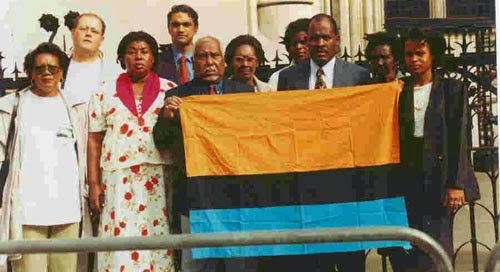The contested United States presidential election in 2000 between Al Gore and George W. Bush made Florida famous not only for ballot-box dysfunction but also for its division on a razor’s edge between Republican and Democratic halves, mirroring the country as a whole. A point of debate between the candidates had been climate change, which Gore, along with most educated and intelligent people, saw as a real threat and which Bush’s supporters scorned—as most Republicans still do—as a scare story in service to a liberal plot to overregulate industry. That same divide was seized upon this month by Democratic leaders in South Miami, including its mayor, as a primary reason that the southern half of the state should split away as the “State of South Florida.”
 |
| Also check out U.S. Constitution, Article IV, Section 3. |
 |
| Miami? Hm, maybe we’ll vacation in Denver this winter. |
 |
| Key West’s self-declared Conch Republic would be part of the State of South Florida under the new plan. |
Less numerous are blue statehood movements in red states, the most prominent of which is a push for a “State of Baja Arizona” centered on liberal Tucson. But none of any of these proposals has any chance of success. After all, U.S. Congress has to approve any new admissions to the union, even those (like Maine and West Virginia, historically) which join through secession. The U.S. political system encourages closely divided legislatures, and therefore the necessary consensus to admit a new state usually occurs only when two states, one for each moiety of the political spectrum of the day, can be admitted in tandem. That pattern was inaugurated with the Missouri Compromise of 1820, in which the slave state of Missouri and the free state of Maine were created nearly simultaneously, and continued right up to the admission of Democratic-dominated Hawaii and Republican-dominated Alaska in 1959. Creating a State of Jefferson would guarantee two new Republican senators on Capitol Hill, while leaving the Democratic hold on what remained of California unchanged, and Democrats would never go for that; likewise with Republican attitudes toward any talk of Baja Arizona.
 |
| Elements in this proposed Baja Arizona flag seem designed to irk Republicans: a French tricolore, and a saguarro cactus that looks a lot like a raised middle finger. |
 |
| The blue counties voted to stay in Colorado in the 2013 non-binding referenda; the orange ones opted to become the State of North Colorado. |
 |
| Some Tea Partiers want to found a red state in the North Woods of Michigan and Wisconsin. |
 |
| Ah, I’m getting all nostalgic for fin-de-siècle America! |
And South Florida is a very low-lying peninsula. Huge parts of it, including nearly all the southern counties that include the Everglades and greater Miami, would be underwater if sea levels rose by, say, 5 to 10 meters (see map below). No one’s predicting a 10-meter rise any time soon, but even a rise of a couple feet would destroy the Everglades and maybe prompt the abandonment of Miami—a city less easy to fortify with levees than, say, New Orleans or the coastal cities of the Netherlands. It puts one in mind of the post-deluvian near-future southern Louisiana depicted in the fanciful 2012 film Beasts of the Southern Wild. It made a good movie, but life there wasn’t pretty.
The South Florida movement, then, may just be the first secessionist movement motivated mostly by fears of climate change. But a five-meter rise would change the political stakes beyond just the Sunshine State. All of coastal Louisiana would vanish, prompting a more wholesale version of what happened after Hurricane Katrina in 2005, when somewhat purplish but still mostly “red” (Republican) Louisiana ended up a more solid bright red after thousands of Democratic-leaning coastal populations like African-Americans, Cajuns, and urban middle-class whites fled the state for good.
As the map below shows, rising sea levels could also have effects that include disrupting democratic and economic reforms in Cuba—possibly prompting a new exodus to (what’s left of) Florida—and chaos in the Yucatan Peninsula, a region of Mexico dominated by Mayan Indians, a group which spearheaded the Zapatista anti-globalization uprising in Chiapas and elsewhere in 1994. Oh, and one more thing: could Orlando or Atlanta or someplace please find room for the entire population of the Bahamas?
Rising sea levels in the southern Caribbean would bring disruptions to Venezuela’s oil industry and turn politics upside-down there, including anti-socialist (and to an extent C.I.A.-stoked) rebellions in the westernmost and most oil-rich state, Zulia. French Guiana’s coastline would be swallowed up, raising the question of whether France will want to give up that lucrative colony, currently the largest remaining overseas territory of a European country other than Greenland (which, incidentally, by this time would be independent and richer than Kuwait due to suddenly accessible energy resources in the ice-free Arctic Ocean).
Turning to northern Europe (see below), among the cultures which might vanish if sea levels rose is the nation of Frisia, concentrated mostly in the Netherlands but also including parts of Denmark and Germany. The Dutch could protect part of their territory from the sea, but not all of it. (This could bring normally dormant interethnic tensions into relief—and we don’t even need to mention Belgium, where most of the land swallowed up would be low-lying Flanders.) And London, if it survives, will have to be a below-sea-level city like New Orleans, constantly worried about floods and the strength of its levees. Avoiding that stress by decamping to Brighton for the weekend will seem a less attractive option after the Gulf Stream diverts away, so maybe it’s time for a holiday in Florida—oh, no, wait, never mind.

Southern Europe would be in better shape. If the European Union, Israel, Turkey, and the Arab League pooled their resources, they could easily install locks at the Strait of Gibraltar and keep the Mediterranean Sea at any level they want, thus saving cities like Istanbul, Venice, Barcelona, and Alexandria from inundation. Suddenly, southern Europe would be the rich part of the E.U., with flood-ravaged countries like Germany and Denmark going cap-in-hand to the high-and-dry booming economies of Greece and Italy.)
 |
| The Pillars of Hercules: nec plus ultra except lots and lots of water. |
Perhaps worst off will be Bangladesh. With more than half the U.S.’s population packed into a region of fragile deltas and sandbars the size of Wisconsin, and millions living on the brink of survival anyway, this poorest of the poor among major nations could become a demographic Cheronobyl in the middle of Asia. Already, the bloody war of independence from Pakistan in 1971 and hopeless miring in poverty and coastal erosion since then have created an exodus of Bengali Muslims into neighboring countries. In nearby parts of India, Hindu and Christian ethnic militias have long been itching to expel Bengalis from their territories, and in Burma (Myanmar) Buddhist-led pogroms against the Rohingya people—800,000 stateless Muslims marginalized by the state as “Bangladeshi squatters”—has derailed the ruling junta’s attempt to liberalize and present itself to the world as a responsible global citizen. Imagine what it would do to Burma and India if, instead of tens or hundreds of thousands of displaced Bangladeshis, they would be asked to absorb, oh, say, 70 million of them. Especially since Burma would be losing much of its coastline too.
Though their population is dwarfed by the countries listed above, it is possibly the minuscule nations consisting mainly of low-lying islands that have the most to fear from rising sea levels. The Bahamas in the Caribbean (see above); Kiribati, Nauru, and Tuvalu in the South Pacific; and the Seychelles and Maldives in the Indian Ocean are among those nations which could disappear altogether if the seas rose more than a little bit. The highest Maldivean point of land is seven feet above sea level, and for several terrifying minutes during the Boxing Day tsunami of 2004 the entire Republic of the Maldives was underwater. If a situation like that became permanent, not only would there have to be material provisions made for the survival of such populations, but a whole rethinking of the idea of nation might have to take place. Hundreds of local cultures could become like the sovereign but landless Military Order of the Knights of Malta, or like the Roma (Gypsy) people, or, in a closer analogy, like the Chagossians—the native people of Diego Garcia in the British Indian Ocean Territory who were deported by the British and Americans in the late 1960s and early ’70s to make way for NATO bases and who now live mostly in the village of Crawley, in County Sussex, England, dreaming of home and trying to keep their culture and dignity together. (See a recent article from this blog on the Chagossians.)
 |
| The Chagossian nation has a flag but no place to plant it. Could Kiribatians and Seychellois one day be—pardon the expression—in the same boat? |
 |
| “It’s a small world after all” ... you know, especially the land part of it |
[For those who are wondering, yes, this blog is tied in with my forthcoming book, a sort of encyclopedic atlas to be published by Auslander and Fox under the title Let’s Split! A Complete Guide to Separatist Movements and Aspirant Nations, from Abkhazia to Zanzibar. (That is shorter than the previous working title.) The book, which contains dozens of maps and over 500 flags, will be on shelves and available on Amazon in February 2015. I will be keeping readers posted of further publication news. Meanwhile, please “like” the book (even though you haven’t read it yet) on Facebook and see this special announcement for more information on the book.]








